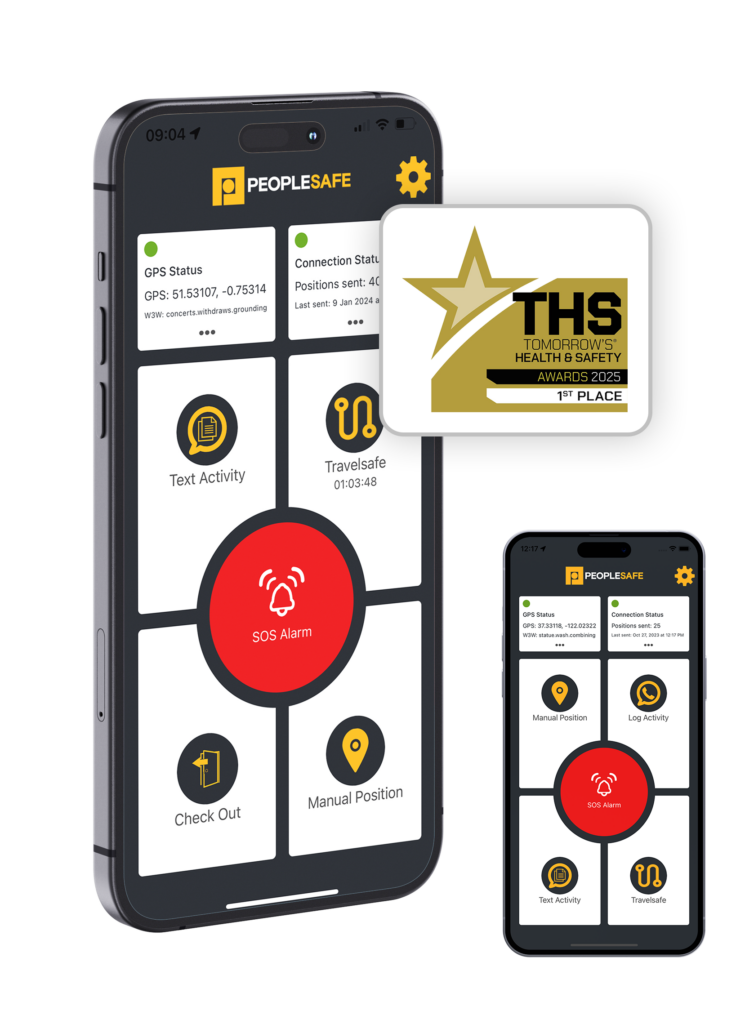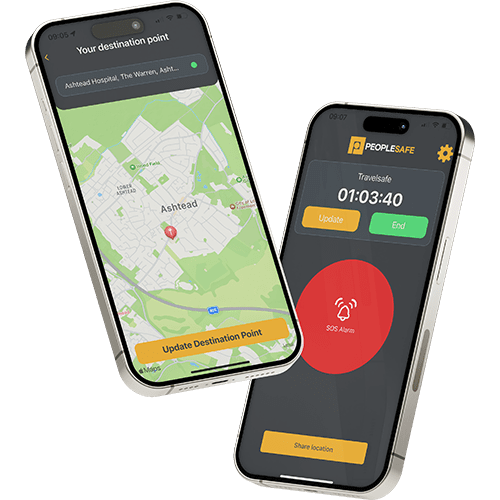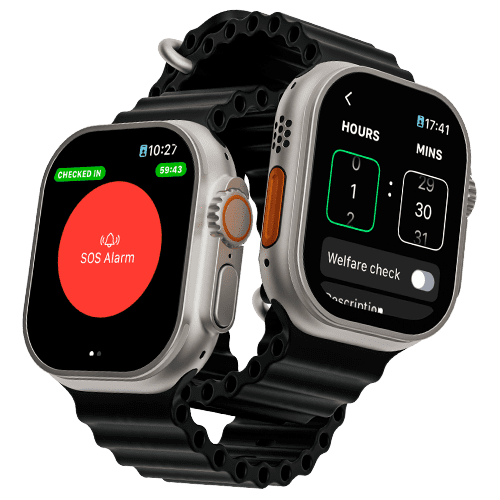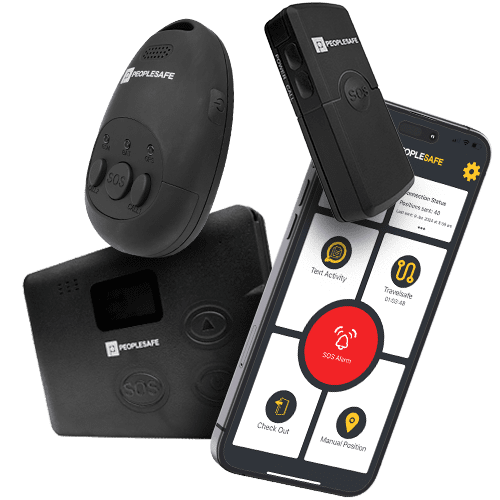Best Lone Worker App
Looking for the best lone worker app? We have compiled a comprehensive review and comparison of the top lone worker apps on the market, including Peoplesafe, StaySafe, and SoloProtect, to help you find the optimal solution for your workforce.
What Are Lone Worker Apps?
Lone worker apps transform a smartphone into a lone worker alarm. Always choose a BS 8484 accredited lone worker app for guaranteed emergency service response. They provide real-time location tracking, direct connectivity to professional monitoring centres and a range of other features – depending on the service – all without the need for additional devices.
These apps have gained significant popularity in recent years, and the Berg Report projects this growth to continue. By the end of 2027, it is expected that 58% of the total lone worker user base in Europe will be using apps, up from 47% in 2022.
Why Should I Use a Lone Worker App Instead of a Lone Worker Device?
Many organisations are increasingly shifting from dedicated lone worker devices to app-based solutions. This transition is driven by the growing preference for the convenience, scalability, and cost-effectiveness of mobile apps.
The number one reason many organisations turn to apps is because of their cost-effectiveness. Since most employees already carry smartphones, there’s no need to purchase additional hardware. This eliminates the upfront cost of lone worker devices and reduces ongoing maintenance and equipment replacement costs.
Another reason organisations are turning to apps is their familiar interface. Since most employees are already comfortable using smartphones, apps tend to be more intuitive and user-friendly than standalone devices. This familiarity ensures that employees can quickly and easily engage with the app. For many organisations, this ease of use boosts adoption rates and ensures that employees are more likely to rely on the app when needed.
Beyond this, offering a lone worker app can serve as an added benefit for employees. Most workers will carry their smartphones with them everywhere in their personal lives, so safety features integrated into these devices can be seen as a valuable perk. For example, features like Travelsafe which offer protection for employees while walking, cycling, using public transport or driving have the opportunity to have a real impact on employee’s wellbeing outside of work. The service operates 24/7 so by providing access for employees to use this whenever they need, employers can keep their employees safe while boosting employee engagement and satisfaction.

Which Lone Worker App Should I Choose?
To help you decide which is the best lone worker app for your organisation, we’ve outlined the key features, pros and cons of some top lone worker safety applications available today. Choosing the right app depends on several factors, including
- the size of your workforce,
- the nature of the risks involved, and
- how easily the app integrates with your existing systems.
By evaluating these aspects, you can select an app that meets your organisation’s safety needs while ensuring ease of use for your lone workers. We hope this breakdown helps you make a well-informed choice, providing your employees with essential support and peace of mind.
We have reviewed:
(Click on the above links to quickly access the relevant section.)
1. Peoplesafe – The Best Enterprise Lone Worker App
According to the Berg Report, Peoplesafe is the world’s largest provider of lone worker safety technology, with the Peoplesafe lone worker app standing as one of its flagship products. Recently recognised as an industry leader, the app won first place in the Tomorrow’s Health & Safety Awards 2025, a testament to its cutting-edge features and real-world impact.
The Peoplesafe app was also the first on the market to achieve BS 8484 accreditation to protect lone workers. There is nothing else on the market that offers the same range of features and integrations.
So, what makes Peoplesafe different from other lone worker apps? One standout feature of the Peoplesafe app is Travelsafe. This solution works by monitoring the user’s journey in real-time – whether they are walking, cycling, driving, or using public transport. If the user fails to reach their destination as planned, an alarm is automatically triggered and sent to the Alarm Receiving Centre, ensuring employees feel supported and protected on every journey.
On Travelsafe, Head of Product at Peoplesafe, John Knowles, said, “We developed Travelsafe to address a critical gap in employee safety, recognising that travel is a source of fear and anxiety for many. By integrating real-time journey monitoring, welfare checks and instant access to professional support, we’ve created a tool that prioritises personal safety and provides peace of mind for employees, wherever they are.”
Secondly, Peoplesafe is the only enterprise-level safety app available on the Apple Watch. Users can set and manage check-ins, raise alarms and access emergency support directly from their wrists without needing their phone. Embedding safety tools into everyday wearables means employees can access essential safety features that enhance their sense of security without the need for additional tools.
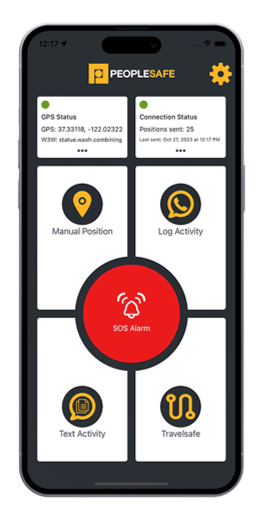
Another standout feature is its integration with video safety technologies, such as Reveal Media body worn cameras and SureCam dashcams. These integrations enable incidents to be responded to as well as recorded with audio and visual evidence available.
Like many on the market, the Peoplesafe lone worker app is linked to an Alarm Receiving Centre. However, what sets it apart is that Peoplesafe’s ARC is wholly owned and operated in-house. Unlike outsourced alternatives, this ensures the service remains entirely focused on lone worker safety without being diluted by other alarm types or competing contracts.
The Peoplesafe app is made even easier to manage with the Nexus customer portal. For managers and administrators, Nexus streamlines the allocation of app licenses allowing them to quickly assign and unassign licenses as needed. It also provides detailed reporting on app usage, giving managers valuable insights into how the app is being utilised across their workforce. For users, Nexus integrates Single Sign-On (SSO), providing seamless access to the app with just one login, improving convenience and security.
Pros:
- Comprehensive Features – Includes all standard lone worker safety features like welfare checks and fall detection.
- Highly Customisable – Tailor the app and its settings to suit the specific needs of employees.
- Award-Winning Customer Portal – Nexus is highly regarded for its ease of use and in-depth reporting.
- Dedicated ARC – In-house Alarm Receiving Centre isn’t diluted by other services or organisations.
- Wide Integration Capabilities – Can integrate with various safety devices like dashcams and body worn cameras.
- Travelsafe – Monitors employees’ journeys and raises an alarm if they fail to reach their destination.
- National Response Service – Provides in-person assistance during non-emergency situations.
Cons:
- Location Tracking Is Not Live – The app’s location tracking updates at set intervals, which can be turned to every minute, rather than offering real-time, live tracking. While this may be seen as a drawback for some, it is designed to prevent excessive battery drain on the user’s phone, which is a common issue with live tracking.
2. StaySafe (Eco Online)
StaySafe, part of EcoOnline, provides a flexible and user-friendly app designed to protect employees in high-risk roles. The app offers safety features, including manual check-ins, fall detection and real-time GPS tracking. This allows employers to track the precise location of their lone workers and respond quickly in case of emergencies.
One unique feature is Driving Mode, which suppresses notifications while the user is driving, to enhance safety while employees are on the road. This ensures that workers are not distracted by app alerts or check-in reminders, allowing them to focus entirely on driving.
The app also offers privacy features. With Privacy Mode, employees can control when their location is visible. Location data is hidden within the online portal and only becomes visible if an alarm is triggered, helping to protect workers’ privacy. Additionally, StaySafe helps reduce false alarms by notifying users and their monitors when the phone battery drops below 5%, ensuring timely and accurate alerts.
However, StaySafe’s outsourced ARC manages a variety of responsibilities, including CCTV, intruder, and fire alarms, meaning the controllers are not exclusively focused on lone worker incidents. Additionally, outsourcing the ARC may limit StaySafe’s ability to maintain full control over the quality of service provided, which could be a concern for organisations requiring a highly specialised response.
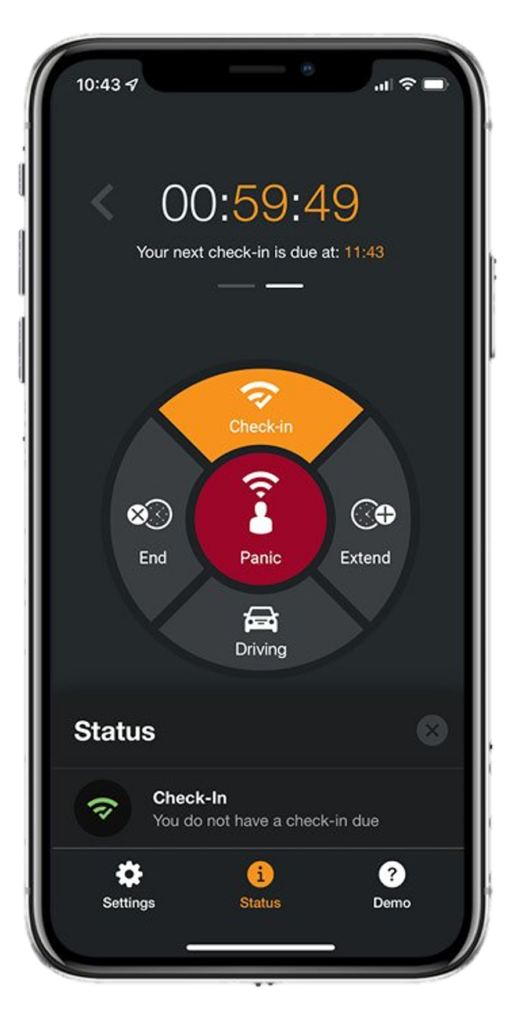
Pros:
- Simple Interface – The app’s easy-to-use design is clear and simple.
- Customisable Alarm Management – StaySafe offers the ability for organisations to manage their own alarms.
- Driving Mode – Driving mode suppresses all notifications and reminders from the StaySafe app, allowing users to focus while at the wheel.
- Real-time Location Tracking – Track workers’ locations with GPS and what3words integration.
- Low Battery Alerts – Users can receive notifications if their battery drops below 5% to reduce false alerts.
- Session Timers & Check-ins – Users can log their shifts and check in at scheduled intervals.
Cons:
- Outsourced ARC – Less control over response times and service quality due to the use of an outsourced Alarm Receiving Centre, which may concern businesses requiring direct oversight.
- Non-specialist Account Managers – EcoOnline’s account managers handle clients across various services, such as Chemical Manager, e-Permits, and ESG, rather than specialising in lone worker safety, which may limit their expertise in addressing specific safety concerns.
- No Shake to Panic – The app lacks a shake-to-panic feature, limiting quick, discreet access to emergency help.
- Limited Mass Notification – Mass notifications can only be sent by group, not by geofencing, which restricts the ability to target specific areas or regions during an emergency.
3. Total Mobile
Totalmobile (previously Lone Worker Solutions), is another comprehensive option for lone worker safety, offering a broad range of features. Like Peoplesafe, Total Mobile provides its own dedicated Alarm Receiving Centre (ARC), available 24/7 and accredited to BS 8484. They also offer all the standard features, including timed activities, welfare checks and fall detection (which they term ‘worker down’).
One standout feature of Total Mobile is its Group Alert functionality. This allows managers to send updates or important information to a predefined group or specific individuals, ensuring that teams are quickly made aware of hazards or emergencies. This feature streamlines communication during critical situations, improving the overall response time.
Another unique feature is Safe Beacon, a geofencing tool that can be used to create virtual perimeters, such as a work site or designated area. When a worker enters or exits this predefined zone, customisable alerts are triggered. This feature can be used to monitor employees’ movements, ensuring they remain within safe or authorised areas
The accompanying management portal allows organisations to configure escalation procedures based on individual risk assessments, ensuring that the appropriate response is triggered in emergencies. The portal also offers visibility into device usage, alert triggers, and the locations of workers, streamlining incident management.
However, despite its range of features, some reviews have noted that the portal’s user interface can be difficult to navigate, especially when managing large teams or responding to multiple alerts. This lack of intuitive design can slow down response times, potentially impacting incident management. Additionally, while the app offers a range of useful features, some users feel that it lacks the customisation flexibility seen in other solutions, limiting its ability to be fully tailored to specific organisational needs.
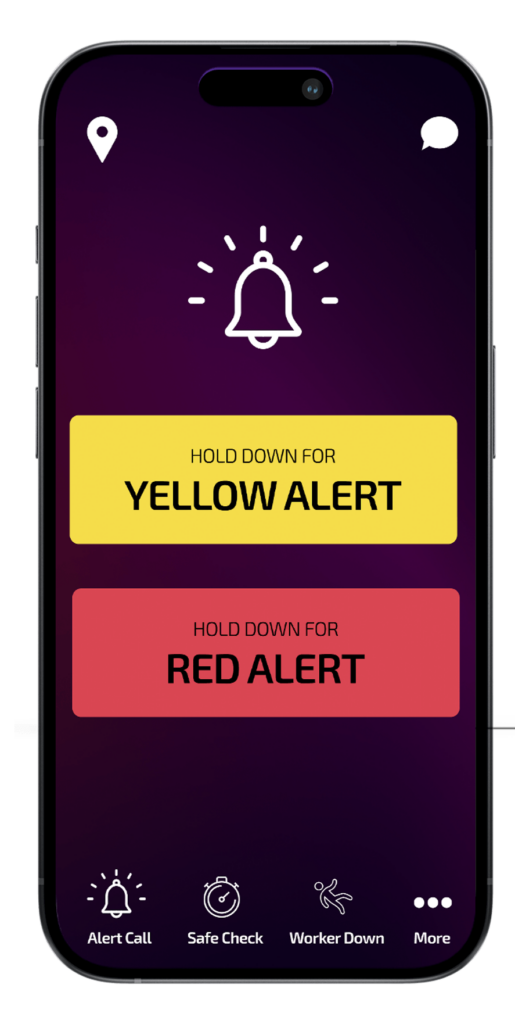
Pros:
- Dedicated ARC – In-house Alarm Receiving Centre isn’t diluted by other services or organisations.
- Comprehensive Features – Includes all standard lone worker safety features like welfare checks and fall detection.
- Group Alert – Sends updates or alerts to predefined groups of staff.
- Safe Beacon – Geofencing feature that sends alerts when workers enter or exit a designated area.
Cons:
- No Free Trial – Unlike some competitors, Lone Worker Solutions does not offer a free trial period.
- User Interface Challenges – Portal can be difficult to navigate, especially when managing large teams.
4. SoloProtect
SoloProtect provides a robust lone worker app solution, offering a range of features tailored to enhancing communication and response in emergency situations.
SoloProtect’s app offers a mass notification system, which allows organisations to send real-time alerts to mobile app users. This ensures workers are quickly informed of any risks, making it easier for them to take action. In addition, the system provides the ability to target specific groups or individuals, allowing for tailored communication depending on the nature of the incident.
The app is backed by SoloProtect Insights, an online platform for managing worker safety. This cloud-based tool supports onboarding, training and reporting, offering management teams critical data such as location tracking and alarm evidence, aiding in proactive risk management and incident resolution.
However, some reviews have noted that the mobile app’s interface can feel a bit clunky, especially when navigating through the various features. Additionally, while SoloProtect provides a comprehensive set of safety features, its integration with third-party devices is limited compared to some other solutions, which may be a drawback for organisations looking for a more flexible, all-encompassing safety solution.
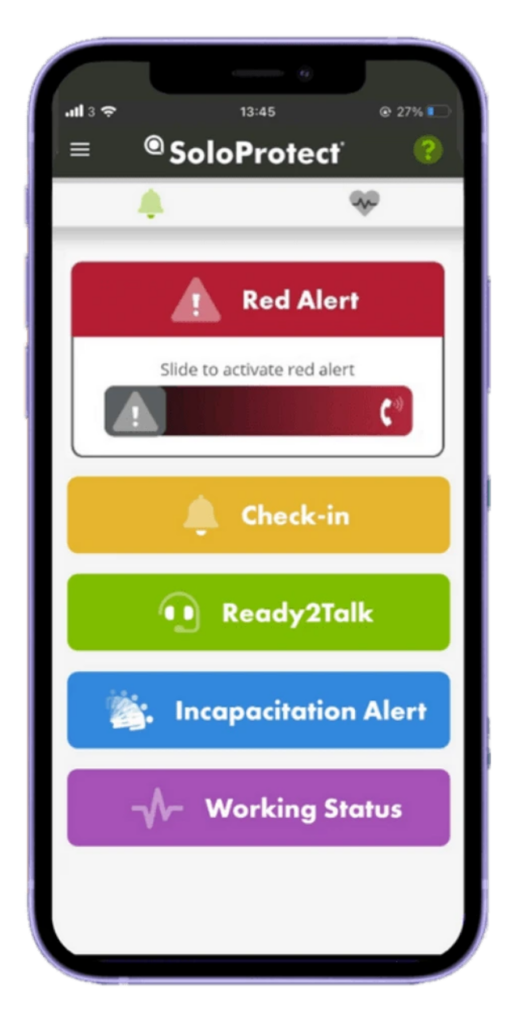
Pros:
- Dedicated ARC – In-house Alarm Receiving Centre isn’t diluted by other services or organisations.
- Comprehensive Features – Includes all standard lone worker safety features like welfare checks and fall detection.
- Mass Notifications – Send alerts to mobile app users, ensuring quick dissemination of information during emergencies.
Cons:
- No Free Trial – Unlike some competitors, SoloProtect does not seem to offer a free trial period.
- User Interface – Some users find the mobile app’s interface to be clunky/hard to use.
- Amber Alert Requirement – Users must provide an amber alert for each new task, which can be frustrating and inconvenient for users.
5. Safepoint
Safepoint provides a more basic lone worker safety solution, offering a range of essential features but lacking in unique add-ons. The app includes core functionalities such as manual panic alerts, time-out alarms, fall detection, and real-time GPS tracking, allowing employers to monitor workers’ locations and safety in real time.
One standout feature is the app’s built-in team management tools, which allow supervisors to monitor and manage the safety of lone workers directly from their phones. Managers can track live updates on staff locations, task statuses, and safety alerts, ensuring quick response if a worker raises an alarm or fails to check-in.
Safepoint also offers an option without the integrated ARC backup. This version is cheaper for businesses that don’t require 24/7 monitoring or want to manage alerts internally.
However, there are some limitations. While fall detection is a key feature, it’s only available when paired with wearable devices, which may be inconvenient for workers who don’t wish to carry or wear additional equipment. Additionally, Safepoint’s ARC is outsourced to ADT, which can reduce the level of control and oversight compared to an in-house solution, potentially leading to variations in service quality. Enterprise organisations may also find customer support and onboarding limited due to the small size of this start-up. The promoted live tracking can also be a negative, as this drains phone batteries very quickly when used.
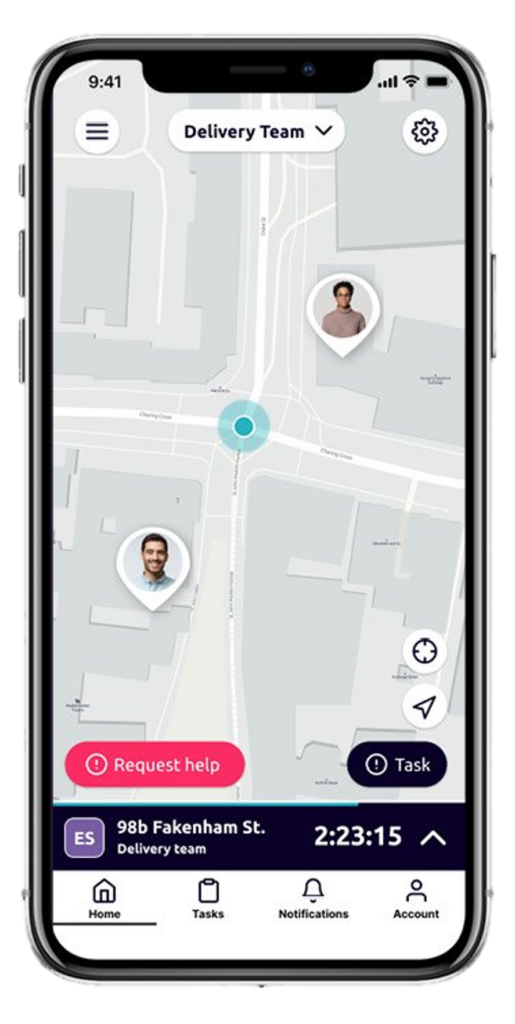
Pros:
- Flexibility – Offers monthly payment plans with no long-term contract commitments.
- Team management – Provides an integrated system for managers to track and manage their teams from the app.
- In-app team management – Allows managers to easily oversee and coordinate their teams in real time directly from their phones.
- Battery and Signal Monitoring – The app shares the worker’s phone battery and signal strength with the users’ guardians, so they can see issues that may affect the worker’s ability to call for help.
Cons:
- Fall detection – Only available with wearable devices, which limits functionality for users who prefer not to use additional tech.
- Outsourced ARC – Less control over response times and service quality due to the use of an outsourced Alarm Receiving Centre, which may concern businesses requiring direct oversight.
- Privacy concerns – Employees may feel uncomfortable with managers being able to track their location in real time, which could reduce app usage and engagement.
- Phone battery – With live tracking, phone battery can drain very quickly.
6. Ok Alone
Ok Alone is a simple, cost-effective lone worker safety app designed to provide essential safety features. It offers real-time location tracking, emergency alerts, and man down, ensuring workers’ safety is continuously monitored. The app is particularly suited for users who need an easy-to-use solution, making this working alone app ideal for employees who aren’t highly tech-savvy.
One notable feature is voice command functionality, allowing workers to trigger safety features via Siri, Alexa, or Google Home. This provides an extra layer of convenience, especially for workers who may be in situations where manually interacting with their phone is difficult or unsafe.
Although Ok Alone does offer an ARC (Safety Monitoring Center), this is only available in North America and not in the UK. Instead, they work with named monitors or an internal SOC, which makes their lone worker app a great option for those who prefer to manage alarms internally.
To support long shifts, the app features a low-battery mode, while its Safety Awards programme encourages user engagement and usage, which is a really nice addition to the overall service, as adoption is a pain point for many.
Plus, Ok Alone provides flexibility with a monthly subscription model that doesn’t lock users into long-term contracts, allowing businesses to scale up or down based on their needs without financial commitment.
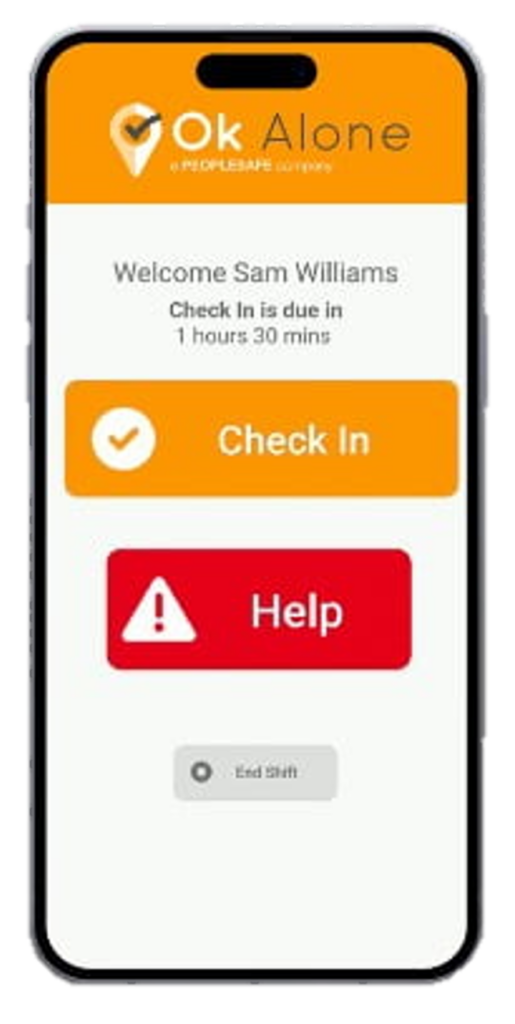
However, the app does not support Bluetooth wearable devices, which limits its functionality for workers who may not always have immediate access to their phones. This can be a concern for employees in situations where using a phone isn’t practical, such as those in customer-facing roles, or completing physical tasks.
Pros:
- Easy to Use – The app’s simple design and easy onboarding make it easy for workers to navigate.
- No Long-Term Contracts – Monthly renewals without long-term commitments, providing flexibility for businesses.
- Voice-Activated Alerts – Hands-free emergency activation through voice commands adds convenience for workers.
- Low Battery Consumption – Battery-saving features ensure the app can be used throughout long shifts without draining the phone’s battery.
- Voice Commands – Allows workers to control safety features via Siri, Alexa, or Google Home for hands-free operation.
- Low Battery Mode – Helps conserve battery life, ensuring the app remains functional throughout long shifts.
- Safety Awards Programme – Encourages employee engagement and safety awareness through reward-based incentives.
Cons:
- No ARC – the lack of an ARC in the UK means that the emergency response won’t be as rigorous or fast as one with an ARC, though it would work well for a company with an established internal ARC/SOC.
- No Bluetooth Wearables – Lacks support for wearable panic devices, which reduces its appeal for workers in customer-facing roles who need to discreetly trigger alerts.
- Limited Features – Lacks advanced options such as journey monitoring, welfare checks, and integrations with devices like body cameras, limiting its suitability for organisations with complex safety needs.
7. LoneAlert
LoneAlert is one of the most basic apps in the lone worker safety market, focusing on simple features aimed at users who require minimal interaction. Key functionalities include timer-based check-ins, where users can set custom intervals and add notes for extra context. The app also sends a notification 10 minutes before the timer expires, though this can be adjusted to suit individual needs
Additionally, LoneAlert does include fall detection, triggering an alert if a user experiences a sudden slip, trip, or fall. Like many other apps, LoneAlert is compatible with a Bluetooth accessory, which enables users to raise an alert without directly interacting with their phone. As long as the switch is within Bluetooth range—around 25 metres indoors and up to 100 metres outdoors—users can discreetly trigger an alert, making it ideal for situations where phone use isn’t practical.
However, the platform does come with limitations. LoneAlert’s web portal has been noted as challenging to navigate, which can impact the ease of managing and responding to alerts effectively. The app lacks many of the advanced features seen in other solutions, such as low signal modes or integration with other safety technologies, making it less suited for high-risk roles or industries requiring more comprehensive monitoring capabilities.
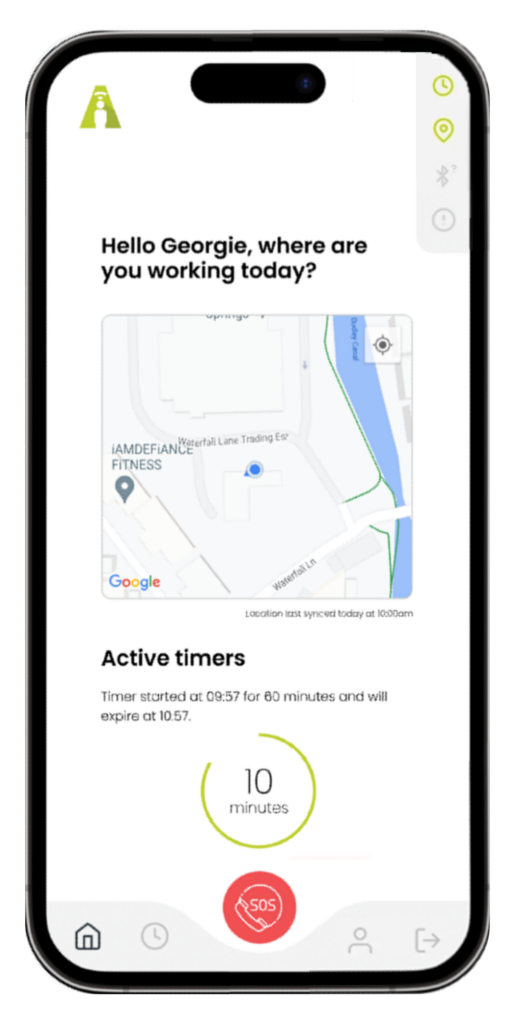
Pros:
- Ease of Use – LoneAlert’s simple interface is easy to navigate, making it a good option for users who need minimal interaction with the app during their shifts.
- Discreet Alarms – The compatibility with Bluetooth accessories allows users to raise an alarm discreetly in situations where phone usage isn’t possible.
- Session Timers & Check-ins – Customisable session timers and alerts help workers manage check-ins and stay on track during their shifts.
- Fall Detection – The app provides essential fall detection, alerting supervisors if a user falls, improving safety for workers at risk of injury.
Cons:
- Lack of Accreditation – LoneAlert does not appear to hold BS8484 accreditation, which may be a critical consideration for businesses requiring the highest standards in lone worker safety.
- Limited Features – Lacks advanced functionalities like low signal modes or integration with other safety technologies, making it less suitable for high-risk environments.
- Unpolished Execution – There are reports of bugs and errors within the app and portal, which could impact its reliability.
App Comparison
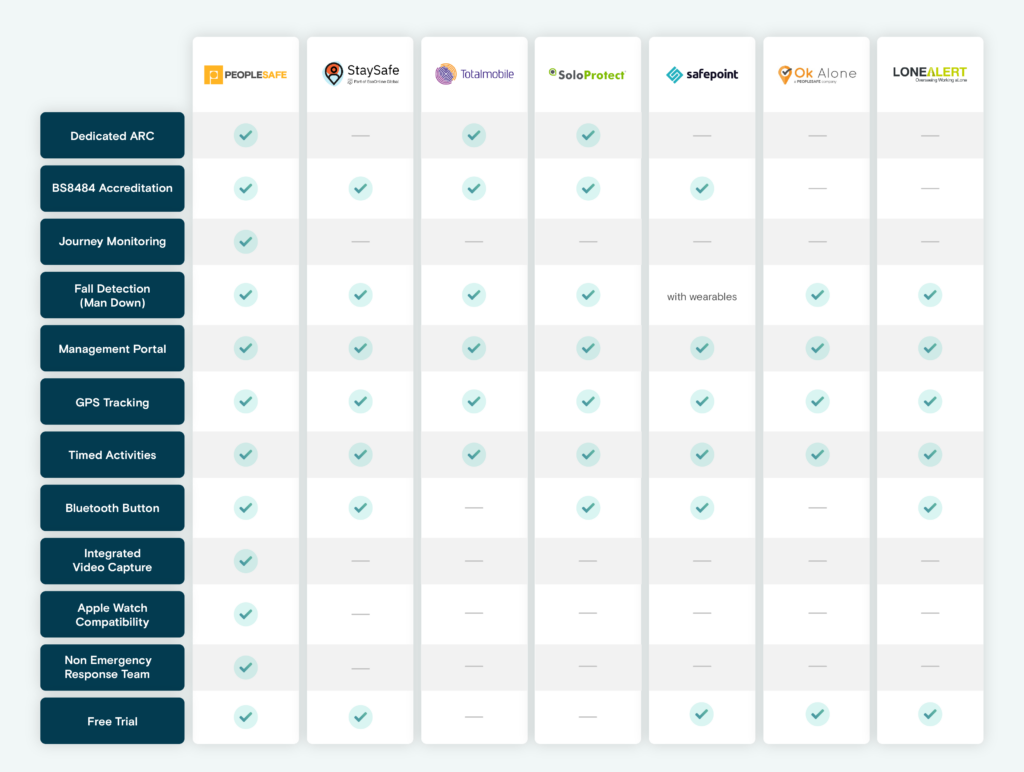
What is the Best Lone Worker App?
In our opinion, Peoplesafe stands out as the most comprehensive and well-rounded lone worker app. From its wholly owned Alarm Receiving Centre (ARC) to its award-winning management portal, it’s clear why Peoplesafe leads the market.
What truly sets Peoplesafe apart for us is its seamless integration with additional safety technologies, such as dashcams, body worn cameras, and the Apple Watch. This flexibility allows businesses of all sizes and risk levels to implement robust safety measures tailored to their needs.
Whichever provider you choose, most offer a demo or free trial to help you determine if the app is the right fit, so it’s worth taking advantage of this if you’re not sure which solution is best for your organisation. We also advise steering clear of any solution that doesn’t meet BS 8484 standards for maximum protection and reliability.

